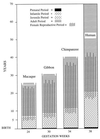Grandmothering, menopause, and the evolution of human life histories
- PMID: 9448332
- PMCID: PMC18762
- DOI: 10.1073/pnas.95.3.1336
Grandmothering, menopause, and the evolution of human life histories
Abstract
Long postmenopausal lifespans distinguish humans from all other primates. This pattern may have evolved with mother-child food sharing, a practice that allowed aging females to enhance their daughters' fertility, thereby increasing selection against senescence. Combined with Charnov's dimensionless assembly rules for mammalian life histories, this hypothesis also accounts for our late maturity, small size at weaning, and high fertility. It has implications for past human habitat choice and social organization and for ideas about the importance of extended learning and paternal provisioning in human evolution.
Figures
References
-
- Feistner A T C, McGrew W C. In: Perspectives in Primate Biology. Seth P K, Seth S, editors. Vol. 3. New Dehli, India: Today and Tomorrow’s Printers and Publishers; 1989. pp. 21–36.
-
- Hawkes K, O’Connell J F, Blurton Jones N G. In: Comparative Socioecology of Mammals and Man. Standen V, Foley R, editors. London: Blackwell; 1989. pp. 341–366.
-
- Hawkes K, O’Connell J F, Blurton Jones N G. Curr Anthropol. 1997;38:551–577.
-
- Blurton Jones N G, Hawkes K, O’Connell J F. In: Comparative Socioecology of Mammals and Man. Standen V, Foley R, editors. London: Blackwell; 1989. pp. 365–390.
-
- Hawkes K, O’Connell J F, Blurton Jones N G. Curr Anthropol. 1995;36:688–700.
MeSH terms
LinkOut - more resources
Full Text Sources
Miscellaneous


